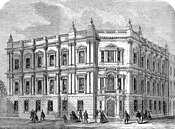Westminster District Board Of Works
Governance

St Margaret was an ancient parish, governed by a vestry and within the City and Liberty of Westminster. Before 1542 the parish included territory between the church of St Clement Danes and the Palace of Westminster, that became part of the parish of St Martin in the Fields.
The Commission for Building Fifty New Churches was set up to build new churches for populous parishes in the London area and Church of St John the Evangelist was completed in 1728. To coincide with this, a new parish of St John the Evangelist for civil and ecclesiastical purposes was split off from St Margaret in 1727.
Despite the split, the two parishes continued to be governed by a single vestry and were commonly known as Westminster St Margaret and St John.
The two parishes were grouped into the Westminster District in 1855 when they came within the area of responsibility of the Metropolitan Board of Works. St Margaret elected 30 members the district board and St John elected 27 members.
Under the Metropolis Management Act 1855 any parish that exceeded 2,000 ratepayers was to be divided into wards; as such the parishes of both St Margaret Westminster and St John the Evangelist within the Westminster District Boards of Works were divided into three wards each (electing vestrymen): St Margaret No. 1 (12), St Margaret No. 2 (9), St Margaret No. 3 (15), St John the Evangelist No. 1 (9), St John the Evangelist No. 2 (15) and St John the Evangelist No. 3 (12).
The local authority was renamed as the St Margaret and St John Combined Vestry in 1887.
In 1889 the parishes became part of the County of London. The united parishes unsuccessfully petitioned for incorporation as a municipal borough on 19 January 1897. In 1900 they became part of the Metropolitan Borough of Westminster. St Margaret and St John was abolished as a civil parish in 1922.
Libraries
The parish vestry was the first in London to adopt the Public Libraries Act 1855. It held a public meeting in 1856, achieved the required two thirds in favour of providing a library and appointed a librarian the same year. The Westminster Public Library on Great Smith Street opened in 1857. In 1858 a further library was opened in Trevor Square, Knightsbridge.
Geography
The main part of the parish fronted the River Thames to the east. St Margaret's was north of St John's. The parish of St Margaret had a detached part of similar size to its west, by the allegiance of a medieval manor, commonly named Kensington Gore and including the northwest of what is today considered Knightsbridge and Kensington Palace.
In times of monasticism and monarchicism, the geographic extent had a maximum of three extra-parochial areas within, namely:
- The Close of the Collegiate Church of St Peter containing Westminster Abbey, officially its own precinct and sanctuary rather than ex-pariochial altogether.
- Privy Gardens (1831 census records)
- Verge of the Palaces of St James and Whitehall (1841 census records)
- Whitehall (1831 census records)
Poor law
Westminster St Margaret and St John was a local act parish and so remained a single unit for administration of the New Poor Law. Following the Metropolitan Poor Act 1867 (30 & 31 Vict. c. 6), it joined with St George Hanover Square for this purpose in 1870 as the St George's Union.
Population
The population history is typical for a central district of London, growing until the 19th century and then declining as transport improvements caused movement to the suburbs. The population peak was in 1871.
| Year | 1801 | 1811 | 1821 | 1831 | 1841 | 1851 | 1871 | 1881 | 1891 | 1901 | 1911 | 1921 |
|---|---|---|---|---|---|---|---|---|---|---|---|---|
| Population | 17,508 | 19,202 | 22,568 | 25,529 | 30,489 | 31,314 | 66,050 | 59,926 | 55,539 | 51,068 | 47,692 | 39,916 |
References
- ^ "Estate and Parish History | British History Online". British-history.ac.uk. Retrieved 14 September 2016.
- ^ Youngs, Frederic (1979). Guide to the Local Administrative Units of England. Vol. I: Southern England. London: Royal Historical Society. ISBN 0-901050-67-9.
- ^ The London Gazette Issue: 21802. 20 October 1855. pp. 3900–3902. Retrieved 9 April 2015.
- ^ "H.M.S.O. Boundary Commission Report 1885 Westminster Map". Vision of Britain. Retrieved 9 April 2015.
- ^ "The London Gazette". 19 January 1897. p. 1. Archived from the original (PDF) on 3 December 2013. Retrieved 14 March 2023.
- ^ Encyclopedia of Library and Information Science: Volume 33 - The Wellesley College Library to Zoological Literature: A Review
- ^ Port, M. H. (Edr.) (1986). "Illustrative map of London parishes". The Commissions for building fifty new churches: The minute books, 1711-27, a calendar. London Record Society.
- ^ "Westminster St Margaret CP/AP through time | Census tables with data for the Parish-level Unit". Archived from the original on 25 December 2013. Retrieved 8 January 2014.
- ^ Peter Higginbotham. "St Margaret and St John the Evangelist, Westminster, London". Workhouses.org.uk.
- ^ "Westminster St Margaret CP/AP through time | Population Statistics | Total Population". Visionofbritain.org.uk. Retrieved 14 September 2016.

